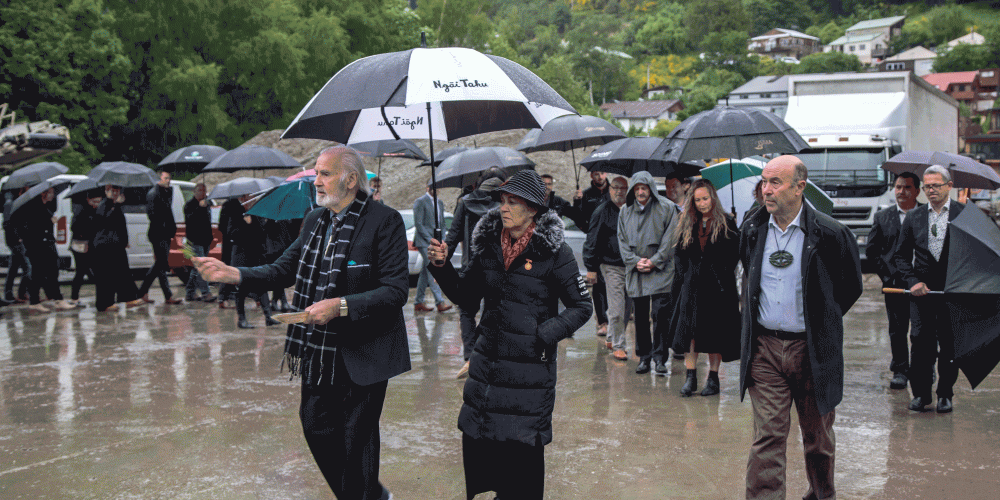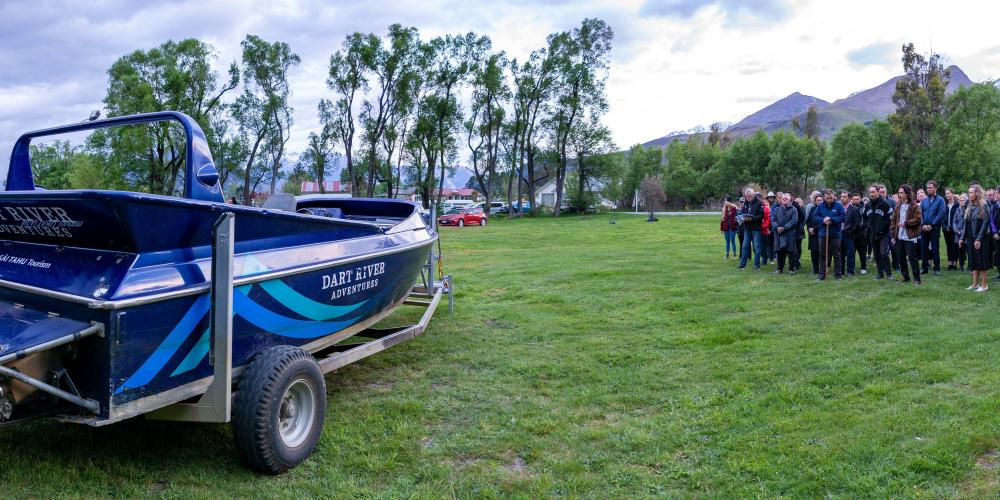Ngāi Tahu Holdings was set up to grow and protect the pūtea (money and assets) returned to the tribe in the Settlement. The company generates income from its investment portfolio and distributes annual returns to Te Rūnanga o Ngāi Tahu. This pūtea is used by Te Rūnanga o Ngāi Tahu to provide support to Ngāi Tahu whānui in areas such as health, education, cultural revival, and the revitalisation of te reo Māori. Today, Ngāi Tahu Holdings manages a range of businesses with farming, honey, property, seafood, and tourism at the heart of its operations. However, the company’s history extends back well beyond its twenty-plus years of operation.
The story of Ngāi Tahu tribal investment and enterprise follows a trajectory from the earliest period of occupation in Te Waipounamu (the South Island), through the turbulent years of colonisation, the fight for Te Kerēme (the Ngāi Tahu Claim), and into the tribe's post-settlement era. Ngāi Tahu people have always been tenacious, innovative, and resourceful. Being innately entrepreneurial, the tribe seized opportunities for trade, with pounamu (greenstone), taramea (perfume), and pōhā kai (preserved foods) being a form of barter currency. Ngāi Tahu had its first contact with European sealers and whalers from around 1795 and by the 1830s had built up a thriving industry supplying whaling ships with provisions such as pigs, potatoes, and wheat. In 1835, whaling and sealing stations began to be established onshore under the authority of local Ngāi Tahu chiefs. The tribe quickly recognised the advantages of new technology, embracing the whalers’ boats, which allowed for safer voyaging and fishing over greater distances, and the ability to handle larger catches. Their larger vessels also opened up the opportunity for doing business offshore including a successful harakeke (flax) trade to Australia from the mid-19th century.
The signing of the Treaty by Ngāi Tahu at Ruapuke, Ōtākou and Akaroa in 1840 set the stage for Pākehā colonisation of Te Waipounamu. In a series of ten major land purchases between 1844 and 1864, the vast majority of the Ngāi Tahu tribal area was sold to the Crown for a miserly sum. Colonists quickly outnumbered Ngāi Tahu on their traditional lands. The reserves that were set aside for Ngāi Tahu throughout their takiwā, were generally inadequate in size and quality and by the close of the nineteenth century, ninety per cent of tribal members were considered landless.
Ngāi Tahu challenged the state for its active neglect of the iwi as early as 1849 calling for the terms of the land purchases to be honoured. Te Kerēme, the Ngāi Tahu Claim, grew out of this protest and the fight for justice became the basis of tribal identity and solidarity for successive generations.
The name Te Hapa o Niu Tireni – the unfulfilled promise of New Zealand – was given to a wharenui at Arowhenua in 1875, and the first ‘fighting fund’ to support the campaign was established that year. This fund was perhaps the earliest collective monetary ‘investment’ by tribal members in their shared futures. Donations collected from kāinga throughout the Ngāi Tahu tribal area were used to meet the costs associated with hui, legal fees, and the preparation of petitions to Parliament.

Despite several commissions of inquiry in the late nineteenth century supporting Ngāi Tahu assertions of wrongdoing on the part of the Crown, the iwi gained little relief. In 1907 the Ngaitahu and Ngatimamoe Executive Committee was established to regenerate tribal efforts to advance Te Kerēme. Once again, tribal members were levied for a ‘fighting fund’. This money was carefully invested and drawn upon to further the Ngāi Tahu cause.
In 1909 the Chair of the Committee Tiemi Hipi and 916 others signed a petition seeking an investigation into Kemp’s Deed (the Canterbury land purchase). This petition proved pivotal, eventually leading to a ruling in favour of Ngāi Tahu; in 1921 the Native Land Claims Commission recommended the tribe receive £354,000 in monetary compensation for loss of their lands
Ngāi Tahu signalled long term investment plans for this anticipated compensation as early as 1919 when John Hopere Uru from Tuahiwi (MP for Southern Maori and secretary of the Executive Committee) insisted that a certain proportion of any compensation paid out should be ‘left untouched for the benefit of future members of the tribe’. However, Ngāi Tahu would have to wait a further 23 years before legislation was finally passed that would deliver any substantial payment. In the meantime, the first Ngaitahu Trust Board was established by statute in 1929. The Trust Board was set up as a body corporate to administer all funds held by it for the benefit of the Ngaitahu tribe and was charged with continuing negotiations with the Crown for settlement of the Claim. The Trust Board was also able to buy and sell property, erect buildings, farm and administer lands it owned, and lend money
While preliminary discussions between the Trust Board and government officials were positive, little progress was made on the Claim throughout the 1930s. By 1937, there were five vacancies on the Trust Board and despite complaints from Ngāi Tahu, the government deferred any further board appointments until the Claim had been settled. Finally, in 1944 the first Labour government made the state’s first major concession to the Ngāi Tahu Claim. The Ngaitahu Claim Settlement Act authorised annual non-inflation adjusted payments to the iwi of £10,000 a year for 30 years.
While the Crown failed to adequately consult the tribe before the legislation was passed, there was a general acceptance of the Act amongst Ngāi Tahu on the grounds that something was better than nothing. The Ngaitahu Trust Board was reconstituted in 1946 to administer the payments and after its establishment, bought a small building in Kaiapoi as its headquarters.
As required by its establishing legislation the board implemented a ‘two-thirds investment’ policy by which two-thirds of the annual £10,000 payment was invested in an ‘Investment Account’, with the remaining one third distributed to beneficiaries, primarily through kaumātua (elderly) and education grants. This state-imposed investment strategy left the board with only £3000 a year which then equated to around £1 per head of the Ngāi Tahu beneficiaries. Despite the paternalism of the legislation, it entrenched a business approach Ngāi Tahu would take into the future - balancing careful investment against distribution to whānau.
Initially the Trust Board invested in Government Stock before diversifying their investment portfolio across different banks, bonds, and property to spread the risk. The Trust Board made grants to beneficiaries for marae expenses, hardship, trade and professional training, secondary schooling, and university study. It also began to think boldly in terms of investment and in the early 1950s sought (unsuccessfully) Ministerial authority to take out a loan to facilitate the purchase of Waikura Station on the east coast of the North Island near Gisborne. By 1955 the Trust Board had assets valued at £85,895 which included investment properties in central Christchurch and Kaiapoi however tribal beneficiaries had begun to lose confidence in the Trust Board complaining about lack of service and poor communication between the Board and its beneficiaries.

The 1956 board elections resulted in a largely new Trust Board with Frank Winter as Chairman, a position he would hold until 1973. Under his leadership, a range of rigorous administrative changes were introduced to reduce cost, increase accountability, and provide for greater strategic investment. Winter’s election coincided with the Trust Board being brought under the jurisdiction of the Maori Trust Boards Act 1955.The new legislation remained deeply paternalistic but did give the board the legal scope to employ a secretary from outside the iwi (under the previous legislation, the secretary was required to be Ngāi Tahu).
While the Trust Board initially advertised for a beneficiary to fill the secretary role, there were no Ngāi Tahu applications, so it determined to appoint a professional accountant, regardless of whakapapa. Subsequently, John (Jack) Lake was employed in 1957, the first of three consecutive non-Ngāi Tahu Trust Board secretaries appointed on the basis of ‘best person for the job’ (an employment principle still adhered to by the iwi today). The Trust Board immediately took action to recover all loans issued to beneficiaries by the former administration and Annual Reports for Ngāi Tahu beneficiaries were produced for the first time, outlining the Trust Board’s investment policies. In a further step to increase accountability, the Trust Board instituted the practice of holding meetings with beneficiaries across the takiwā to provide the opportunity for greater engagement and input from Ngāi Tahu whānui.
The work of the Trust Board was based on the proverb ‘Mō ngā tamariki me ngā kaumātua’, indicating that its funds were to educate children and assist kaumātua (the elderly). Board members vetted all applications for grants, adopting a firm policy that only Ngāi Tahu beneficiaries were to benefit from the board’s funds. The Trust Board also tightened the rules concerning the provision of loans and mortgages, and ordered outstanding loans to be repaid. This tight fiscal policy greatly improved the Trust Board’s financial position enabling it to increase distributions to beneficiaries, whose numbers swelled in 1966 when all people with whakapapa to a Ngāi Tahu ancestor alive in 1848 were deemed beneficiaries of the Trust Board. By the 1960s the board was in a position to focus on securing a more equitable Claim settlement than the compromise of 1944. The Trust Board organised substantial petitions to the Māori Affairs Committee in 1969 and 1972 which eventually secured long-term funding for the Trust Board through perpetual annual payments of $20,000 from the Crown. However, these payments were still non-inflation adjusted so to keep up with rising costs, the Trust Board moved away from investment in mortgages and into property instead.


Early investments included the ‘Avon ’ and ‘Barton’ flats in Wellington which proved excellent performers in the rental market. In 1972 the Board transferred these properties into a non-taxable charitable trust for education purposes. By the mid-1970s property had become the cornerstone of the Trust Board’s investment allowing it to increase the amount of funding it distributed to rūnanga for projects such as the upgrade of marae facilities.
While the Trust Board was primarily charged with administering the yearly $20,000 payment, it had done (and continued to do) a lot more than that. The Trust Board ‘functions’ specified in the Maori Trust Boards Act 1955 were strongly social welfare focused (including the promotion of health, social and economic welfare, educational and vocational training) however, a permissive clause in the Act had enabled Ngāi Tahu to undertake any actions they considered to be ‘for the general benefit of its beneficiaries’. The Trust Board exploited this clause to its fullest potential, investing in tribally owned and subsidiary companies across a range of portfolios. These investments formed the primary source of income for the tribe.
From the mid-1970s the Trust Board focused all new property investment in Te Waipounamu. This included the commissioning and construction in 1980 of a new building (Te Waipounamu House) on Armagh Street in Christchurch, three floors of which became its offices, with the remaining floors leased. That year, the Board also socialised the idea of an annual hui among its members with the result that the first annual Ngāi Tahu hui was hosted at Ōtākou Marae in 1981. This set the precedent for the tribal gatherings that have evolved into the Hui-ā-Tau and bi-annual Hui-ā-Iwi held today. The Trust Board also expressed an aspiration to invest its funds more widely throughout the South Island (particularly in Otago, Southland and the West Coast) so that the work of the board was more visible to Ngāi Tahu beneficiaries. In an early venture in property development, the Board entered into the development of a showroom, office, warehouse building for Tolley Industries Limited in Christchurch which was completed in 1982. It also acquired the Christchurch Post Office Workshops and leased them back to the Crown.


By the time the Ngāi Tahu Claim was filed with the Waitangi Tribunal in 1986, the Trust Board had accumulated $3.2 million worth of assets, despite substantially increased outgoings arising from a much-enlarged political and cultural role.
The Treaty of Waitangi Amendment Act 1985 had empowered the Waitangi Tribunal to hear retrospective claims dating back to 1840. Ngāi Tahu seized the opportunity to advance Te Kerēme, the Ngāi Tahu Claim. The Trust Board consulted Ngāi Tahu kaumātua who agreed that the Board should fund the legal and administrative costs of taking a claim to the Tribunal by liquidating the tribe’s property portfolio. This undertaking was approved on the proviso that a tribal investment base would be restored as a matter of priority on settlement. The decision was also taken to combine the separate Ngāi Tahu grievances into a single Ngāi Tahu Claim, with any settlement redress to be held centrally for the benefit of all Ngāi Tahu individuals equally.
In the lead up to the Ngāi Tahu Settlement in 1998, the Ngāi Tahu Trust Board emphasised that its establishment of an economic base was taking place at two levels – the Rūnanga level, and the Trust Board level, on behalf of the whole tribe. Wherever possible the Trust Board attempted to involve the local Rūnanga in its commercial activities.
All potential investments were fully researched before any decision was made to invest and in 1992, the Trust Board established guidelines to determine whether or not a particular investment was strategically important to the iwi. In the interests of neutrality and transparency all companies also had directors from outside the iwi as well as from within. By the early 1990s, the Board had established a variety of tribally-owned companies operating in the areas of fishing, tourism and property investment.
The Trust Board was aware of the upcoming land and fish settlements that would boost the process of real economic recovery for Ngāi Tahu. However, they were also aware of the huge responsibility that came with looking after the pūtea (assets) stating: ‘the responsibility is with us to not only protect that asset base but enhance its value so that it will continue to benefit the generations to come – a responsibility which is not taken lightly.’ This responsibility drove the Trust Board to set up adequate legal and operational structures with policies and strategies that would take the iwi into the next phase of its development.


